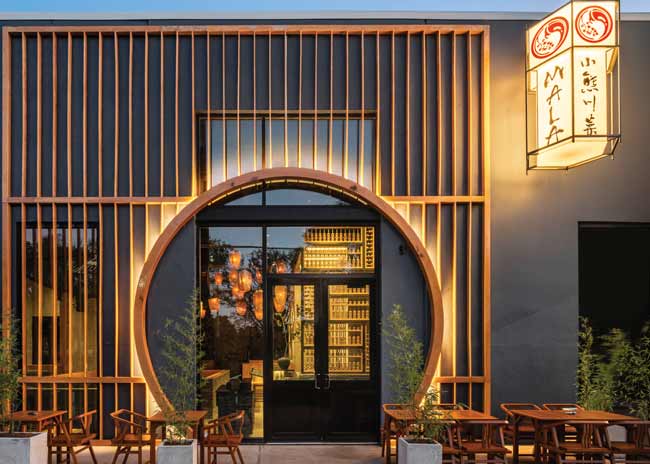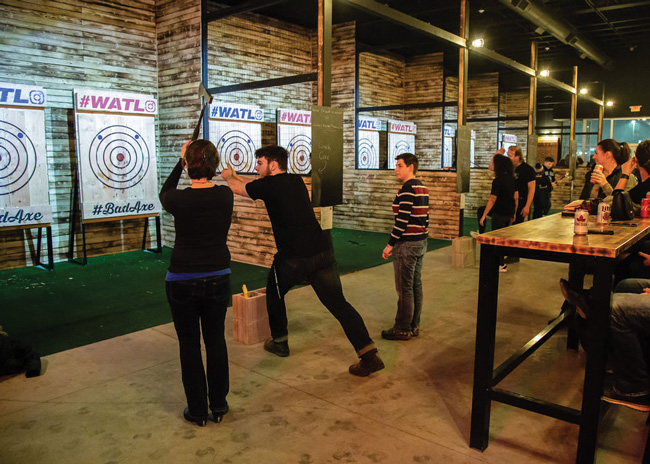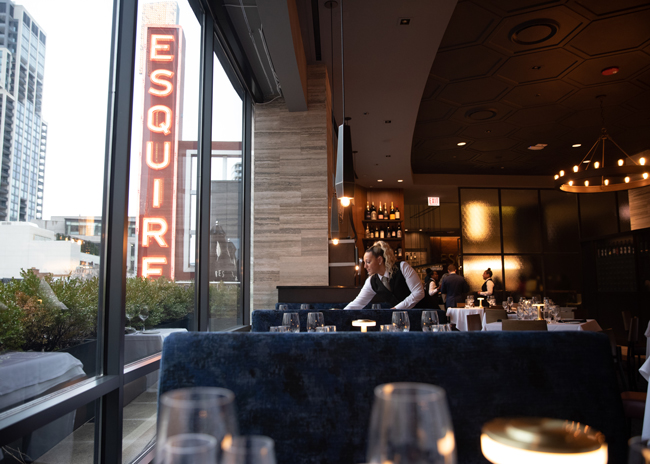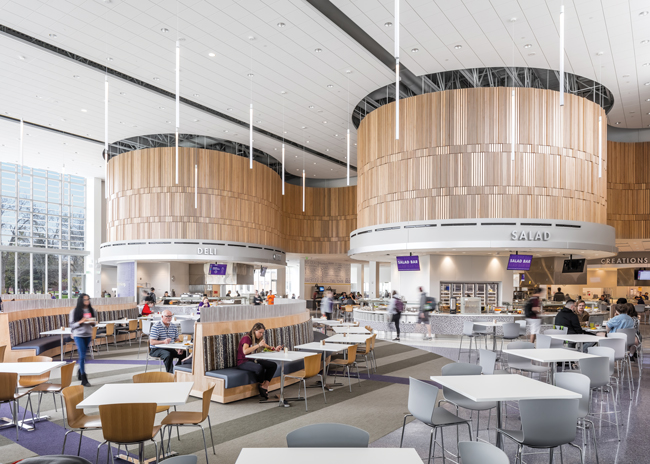 Ricca designed Mankato Dining Hall at Minnesota State University to have a bright, airy feel. Image courtesy of Brandon StengelToday’s college and university students are vocal, opinionated, and knowledgeable about global cuisine — and they know what they do and don’t like to eat!
Ricca designed Mankato Dining Hall at Minnesota State University to have a bright, airy feel. Image courtesy of Brandon StengelToday’s college and university students are vocal, opinionated, and knowledgeable about global cuisine — and they know what they do and don’t like to eat!
These young adults, the restaurant consumers of today and tomorrow, have certain expectations of dining establishments, which can offer a glimpse into what restaurants of the future should be featuring.
Food for students “is identity, it’s entertainment, it’s a very important part of their lives,” says Rob White, president, Envision Strategies, a foodservice consultancy located in Denver.
Because of these high expectations and because universities are competing more than ever before to recruit and retain students, dining facilities on campuses are often second-to-none, featuring an elevated experience and design and more food choices than ever. To wit: Morrison Dining at Cornell University focuses on food as community; One World Cafe at the University at Buffalo offers a top-notch living-learning environment that aims to capture both unity and diversity; and the University of Maryland’s Yahentamitsi dining hall pays tribute to the Piscataway people.
“Schools are competing for students,” says Robert Nelson, chief executive officer, National Association of College and University Food Services (NACUFS), East Lansing, Mich. “Today when people look at the collegiate dining industry, they look at the dining experience being integral to the overall university experience. It’s important to recognize its role in creating community on campus.”
Create Social Spaces
University dining halls are no longer just for eating. Students are using these spaces to hang out with friends, hold meetings, study, and relax.
“People are approaching the dining hall at different speeds,” says Edmond Bakos, CEO of Champalimaud Design, New York City. Champalimaud is the firm behind Cornell’s Morrison Dining where varied seating types offer a variety of experiences in one space: high-top seating close to the food stations for speedy pass-throughs; traditional chairs and tables; softer seating for lingering; and some nooks for people to gather or hide away.
Champalimaud has also defined some spaces with custom lighting to create distinct and intimate zones. And some of the seating at Morrison Dining is around the food stations, or micro restaurants “to reflect the student experience, which is creative, collaborative and multifunctional,” explains Dustin Cutler, senior executive director of dining services.
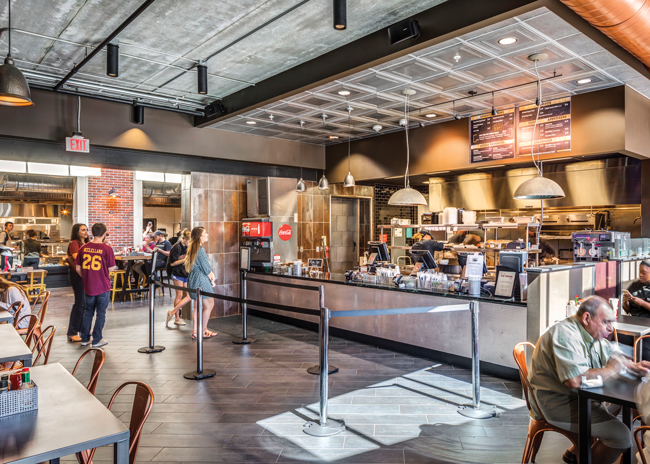 Florida State University’s “1851” dining hall. Image courtesy of Justin Maconochie
Florida State University’s “1851” dining hall. Image courtesy of Justin Maconochie
Allow For Meaningful Interaction
At Morrison Dining, students are encouraged to chat to the staff, select ingredients and seasonings, and customize their meal as the person makes it.
Students like to interact with the people making their food. Having this connection can help students with nutrition, explains Bakos. “[At Cornell] we tried to construct an interaction, an experience between the culinarians and the students to have a conversation about how something might be prepared or customized,” he explains.
“Students love technology, but they also love to see a human make food and not a robot,” says Nelson. This is both because they like food “made specific to their taste and needs,” he says, but likely also for the social connection.
Offer Variety and Flexibility
Since college campuses are filled with students from around the globe, foodservice offerings need to be diverse. There must be a plethora of stations in a food hall, says White, and those stations need to be easily convertible from one type of cuisine to another “to help the ops team create more changeable, interesting menus.”
Students want variety and choice, so it’s important that the menus change and evolve “and also that you can create a more inclusive experience,” Nelson says. To achieve this, he suggests installing versatile equipment at each station.
Kris Morphis, principal, Ricca Design Studios, Denver, likes to stick with certain pieces of equipment and avoid others. Rice cookers and woks are great for Asian stations, he points out, but don’t do a lot beyond that, so they’re probably best located in the back of the house.
Combi ovens are much more flexible and have a smaller footprint when compared to two or more pieces of equipment otherwise required for the same tasks. Other versatile equipment includes grills, ranges, and ventless equipment such as fryers “which makes it easier to put [equipment] in and to move it around,” says Morphis.
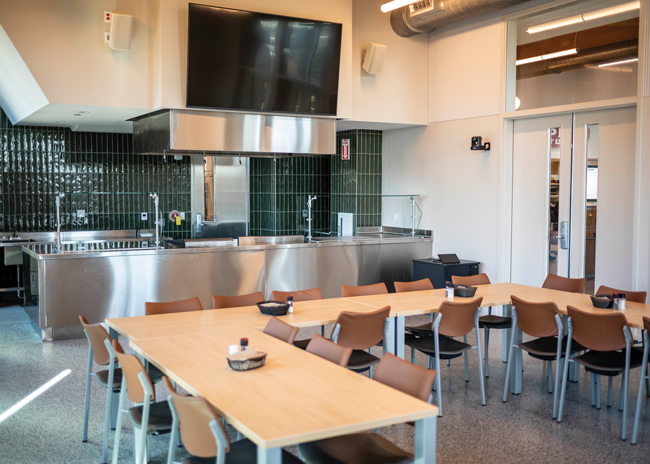 Swarthmore College is one of many offering a teaching kitchen to immerse students in food and wellness.
Swarthmore College is one of many offering a teaching kitchen to immerse students in food and wellness.
Celebrate Teaching Labs
Bringing students together to cook and learn is a focus of college and university dining, says Nelson.
He points to the University of North Dakota’s Culinary Corner, the University of Nebraska’s The Wellness Kitchen, North Carolina State’s Teaching Kitchen, and the University of Maryland’s Yahentamitsi, which incorporates a teaching kitchen.
“In addition to teaching kitchens, we also see learning labs, where research and education takes place around areas like sustainability, food waste, nutrition and more, says Nelson.
Cornell’s Morrison Dining includes the Discovery Kitchen, a 2,400-square-foot lab. This is the gem of the facility, Cutler says. In addition to credited coursework being offered, there are also hosted teaching demonstrations, events such as cooking and baking competitions, team-building workshops, student-focused food literacy events, and celebration festivities.
It was included as part of this building, says Bakos, “with the idea that the educational side of things is not something dry that happens off on the side, but can be an integral.”
“This is a reflection of one of the best campus dining programs. They go beyond great food but also engage or lift up how food can support the academic mission,” says White.
Swarthmore College in Pennsylvania opened a new teaching kitchen this fall “to engage in the many aspects of food and wellness by developing cooking skills and exploring nutrition,” says Linda McDougall, director of dining services. It also, she adds, “introduce[s] students to critical skill-building and food-safety classes, including knife safety.
Design for Speed
While some students are looking for interaction with culinary staff, many are also looking to quickly get in and out with the least amount of friction possible.
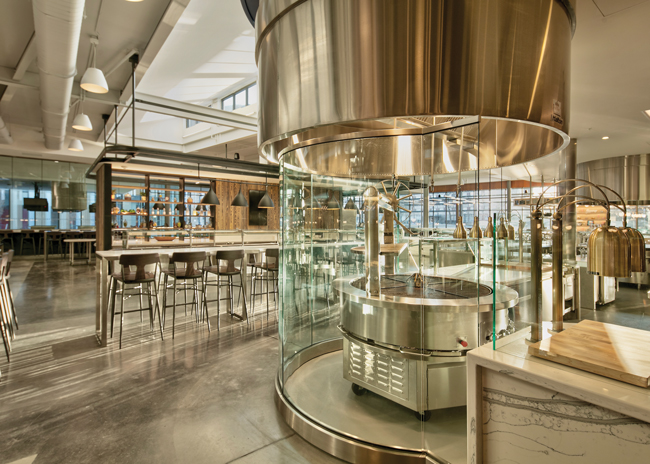 Morrison Dining's West Side Market features the plancha grill, which is used for production. Image by Melissa Hom, courtesy of Cornell UniversityGrouping stations together can allow food halls to open and close gradually, so only two or three are open early and late in the day, Bakos says. “At Cornell, we created a cluster around a few stations that would do everything,” he points out, adding that breakfast stations, for example, are close together. This also allows staff to migrate from one to the other if needed, and groups students, creating more energy in the space.
Morrison Dining's West Side Market features the plancha grill, which is used for production. Image by Melissa Hom, courtesy of Cornell UniversityGrouping stations together can allow food halls to open and close gradually, so only two or three are open early and late in the day, Bakos says. “At Cornell, we created a cluster around a few stations that would do everything,” he points out, adding that breakfast stations, for example, are close together. This also allows staff to migrate from one to the other if needed, and groups students, creating more energy in the space.
White’s been surprised to see, however, that students are prepared to wait for their food, even for up
to 30 minutes, “because they have their phone as a companion, they’re being productive.”
Technology is a great way to get students in and out for grab-and-go occasions, or once they’ve ordered online, Nelson says. Some colleges are shifting from having an employee in grab-and-go sections to having an employee at the entrance, welcoming people and adding the human touch there.
Be Aware of Allergens
In January, Duke University opened It’s Thyme — its first location to ensure none of the top nine food allergens (milk, eggs, wheat, fish, shellfish, peanuts, tree nuts, soy and sesame) are served. It’s Thyme is a build-your-own bowl concept, so students enter and pass along a line and each meal is personalized. There’s also a mobile ordering pickup spot.
“We’re always making sure our program is inclusive,” says spokesperson Kirsten Richards, adding that this is what students asked for in focus groups. The foodservice department realized this would need to be a self-contained space to be truly allergen-free.
“Colleges are really catering to what students need,” says Morphis, who’s seeing a lot of allergen-free dining platforms in the segment. He’s also designed several allergy-free rooms that can be only accessed with a key card. “They give those students their own place that is safe and [they] can prep their own allergen-free meals.”
Meals for religious students are also in demand, he adds, such as halal and kosher.
“There is a great deal of creativity, innovation and variety in this space across campuses as dining operations find solutions to address their community’s unique needs,” says Nelson.
Nutritional transparency is another major effort, with many schools employing integrative technologies to provide accurate nutritional information to students, Nelson adds. “Front-of-house operations are actively implementing solutions such as dynamic screens and apps capable of real-time updates.”
An allergen-free kitchen needs to be separate from any other foodservice area, so even tiny particles of allergens can’t enter, notes Bakos. This means stations can operate in food halls but must be isolated, sometimes walled off, and have to have dedicated prep, cooking, and storage spaces. Bakos says universities are shifting to food trucks, which can operate completely independently of other facilities.
A downside of this is a lack of flexibility; these areas can’t be an allergen-free station this week and an Asian station the next. “We design for flexibility in stations, but you have to set aside a certain footprint to be that allergen station or gluten-free station,” Bakos says.
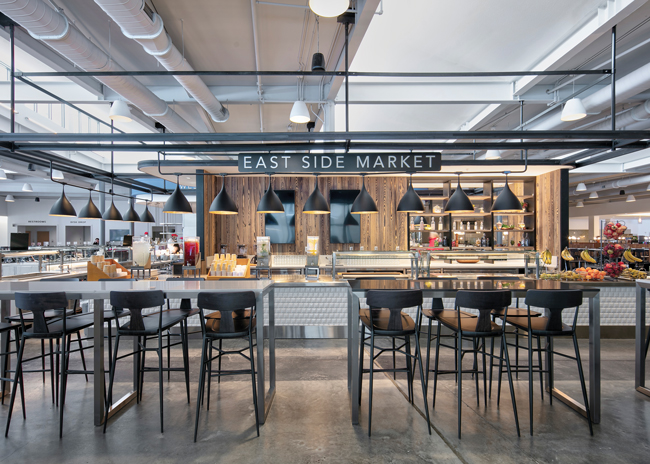 East Side Market is one of the quadrants in Cornell University’s Morrison Dining. Design by Champalimaud Design. Image courtesy of Melissa Hom, courtesy of Cornell University
East Side Market is one of the quadrants in Cornell University’s Morrison Dining. Design by Champalimaud Design. Image courtesy of Melissa Hom, courtesy of Cornell University
Focus on Micromarkets
Colorado State University in Fort Collins is experimenting with unmanned micromarkets, and is operating two, but plans to open more.
These self-service locations are open 24/7 and are especially popular after hours. They’re in underserved areas of the campus and are also intended to be a viable option for students with sensory issues, who are not comfortable in crowded dining halls.
Food for the micromarkets comes from the central production kitchen and the 250 or so SKUs include hot and cold foods ranging from sandwiches and sushi to pot stickers, salads, chips and pastries. Microwaves are available to heat food.
Students check themselves out using cash or meal plans so cameras man the locations and need to be really obvious, says Patrick St. Clair, assistant director, support services. “It’s the placement of the camera that’s nailed it home for us,” he
points out.
So far, the micromarkets have opened in repurposed spaces and cost around $20,000, which includes the cameras, around 18 linear feet of shelving, refrigerators, beverage coolers and freezers.
Micromarkets are exploding in popularity. “The convenience factor is huge,” says Bakos. “At the moment it’s stymied a bit because cameras and facial recognition software is very expensive to purchase and operate. As that becomes more common, I think we’ll be seeing that utilized more.” They also alleviate the staffing difficulties many campuses are seeing, he says, since they only need employees for stocking.
Last year Virginia Tech converted a convenience store into a 5,000-square foot grocery/convenience store, Xpress Lane Market that includes Futurebites, which offers hot and cold foods where chefs can showcase new products. “The design of the space allows for changes to occur in layout as needed to stay on trend and demand from the campus community,” says John Barrett, associate director of dining services.

